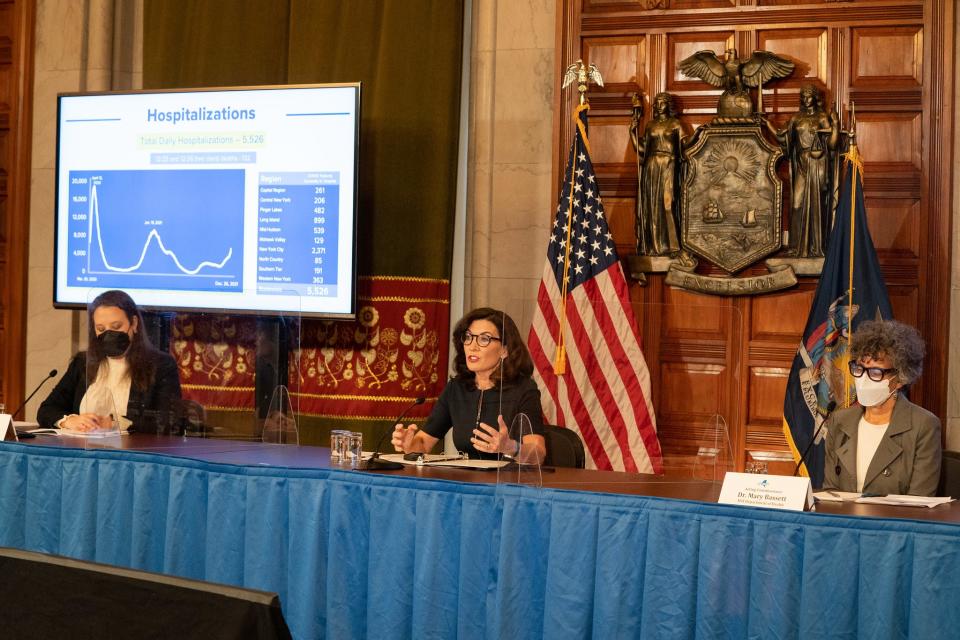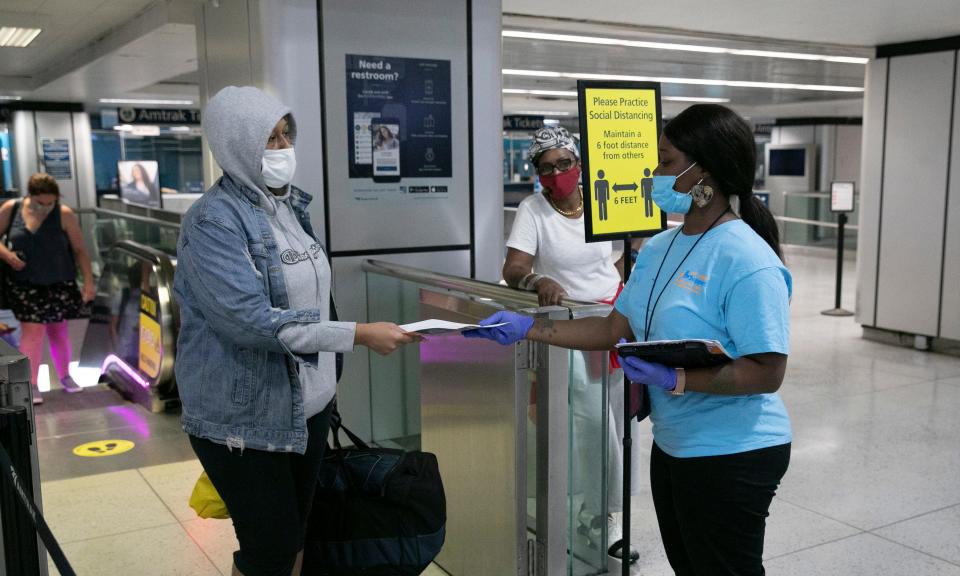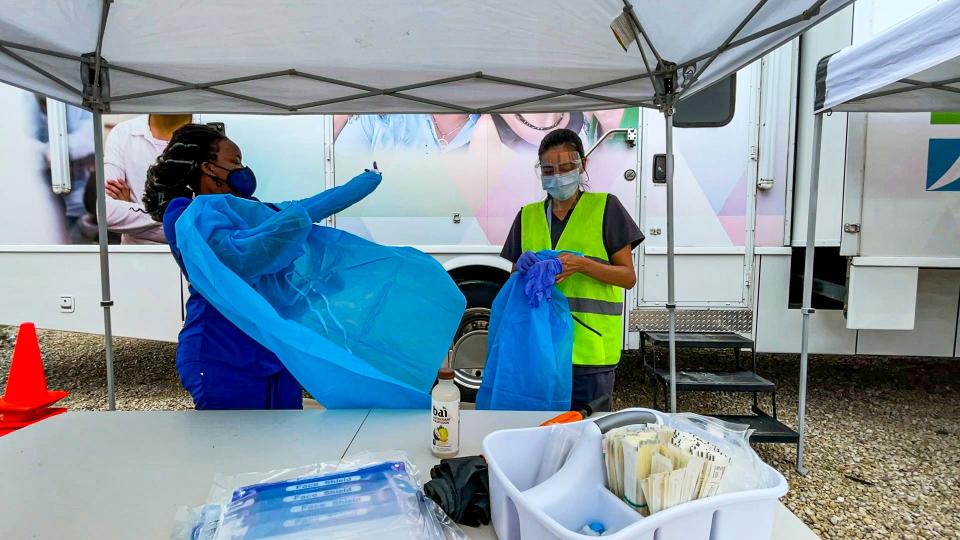How many New Yorkers got tested for COVID while traveling in other states? What we know
- Oops!Something went wrong.Please try again later.
About 2,000 New Yorkers got tested for COVID-19 while traveling in Florida during the initial omicron variant wave this winter, state data show.
The newly reported test numbers offered the first glimpse of omicron’s impact on New Yorkers visiting Florida, as debates raged over the two states’ drastically different pandemic responses.
But the full scope of interstate coronavirus infections remains unclear because few states share test data, according to a USA TODAY Network analysis of state records obtained via public records request.
Among the findings of COVID-19 test data spanning from Nov. 1, 2021 through Feb. 3, 2022:
New York only received test results involving New Yorkers traveling in seven other states – Florida, Illinois, Maryland, California, Ohio, New Jersey and Tennessee.
Many of the 43 other states without data asserted they lacked resources to provide New York with the information, New York health officials said.
A total of about 68,100 tests involved New Yorkers in other states, including some New York City area testing outsourced to New Jersey laboratories.
Test results for New Yorkers in other states are included in New York’s daily tally reported publicly, skewing understanding of the virus’ spread.
DATA: New York and Florida approached COVID-19 differently. What does the data say?
COVID: NY COVID-19 cases stay flat as nation continues to fight BA.5 subvariant
What NY is doing about COVID heading into fall

As authorities brace for a COVID-19 surge this fall, interstate testing gaps joined a growing list of potential blind spots for catching − and containing − outbreaks early. Others include limited at-home test result reporting, as well as the end of most contact tracing efforts.
Meanwhile, New York’s plan for combating COVID-19 allows for ramping up a range of shelved infectious-disease control tools used earlier in the pandemic, such as mass testing and vaccination sites, which closed during lulls in cases.
Heading into the school year, state officials further aim to limit threats by urging students and educators to use at-home tests before returning to classrooms. The state plans to distribute nearly 20 million test kits in the coming weeks.
New Yorkers seeking prescription COVID-19 antiviral pills also have access to 44 test-to-treat sites statewide, as well as a recently launched state hotline −888-873-2869 – offering telehealth consults to access the pills.
“If anything, this pandemic and COVID has taught us, preparations are the key to literally survival,” Gov. Kathy Hocul said recently, detailing the fall strategy.
While schools are currently poised to open without mask mandates, Hochul said she would consider requiring masks in classrooms again, if pandemic conditions warranted, such as hospitalizations skyrocketing or a variant emerging that caused more severe illness in children.
State agencies and health providers are also once again stockpiling masks, gowns, and other personal protective equipment, under measures intended to prevent the dire shortages that cost countless lives in early 2020.
New York’s out-of-state COVID case battle

Despite recent moves to relax many COVID-19 restrictions, New York fueled politically charged debates over outbreaks spreading between states earlier in the pandemic.
Many of the policy clashes focused on New York’s various attempts at imposing domestic travel restrictions aimed at curbing coronavirus outbreaks. Many health experts, however, asserted the policies had limited impact due to the contagiousness of COVID-19 and enforcement hurdles.
In 2020, New York imposed a 14-day quarantine requirement for out-of-state travelers visiting the state.
The complex web of rules applied to those spending more than 24 hours outside New York, and eventually included a test-out option to shorten the quarantine period based on a negative result.
Enforcement of the travel restrictions relied mostly on the honor system, although COVID-19 contact tracers for months asked domestic air and rail travelers arriving in New York to fill out questionnaires related to the effort.
In August 2020, about 67,000 out-of-state students also arrived in New York to hunker down in dorms, apartments and hotel rooms for mandatory 14-day quarantine periods.
Despite the travel restrictions, COVID-19 cases eventually spiked in New York in the late fall of 2020, as holiday gatherings proved the most effective means of spreading the virus.
In April 2021, New York ended the domestic travel restrictions as COVID-19 vaccines became more widely available.
Now, widespread access to COVID-19 vaccines and antiviral pills makes the prospect of a return of domestic travel bans unlikely, as many people are protected against severe illness and death, said Dr. Aaron Glatt, an Infectious Diseases Society of America expert.
But people should still weigh risk factors, such as higher infection rates and hospitalizations, when considering traveling, said Glatt, who oversees infectious diseases at Mount Sinai South Nassau Hospital.
Intensive care unit usage and death rates, he added, have recently become the most accurate gauge of COVID-19 risk levels for a specific community due to gaps in case tracking and incidental COVID-19 positives involving hospital patients with unrelated illness.
“People need to make individual decisions, taking into account the data as best as they possibly can,” he said, adding: “It’s a far more nuanced approach than it was previously.”
COVID policy: Florida and New York share an interstate, but their COVID cultures are worlds apart
Polio in NY: Polio in Rockland wastewater as early as June, samples show
What we know about out-of-state COVID tests

Many of the out-of-state COVID-19 test results involved New Yorkers getting tested in New Jersey, or New York specimens outsourced to New Jersey labs.
A total of about 66,000 of the tests fell into the New Jersey category, while Florida accounted for most of the remaining tests. The five other states reported a total of just 13 test results to New York.
Health care: NY health insurers propose nearly 19% rate hike, say COVID-19 costs, inflation are to blame
Of the 68,100 tests, about 6,000 were deemed positive. Another roughly 1,200 test reports either lacked result details or were deemed invalid.
About 270 of the 2,000 tests in Florida were positive, with another 205 lacking result details.
While New York received test data from ordering facilities in just seven states, some of the cases involved providers from a handful of other states, suggesting links to additional travel-related testing where specimen processing was outsourced.
Yet the lack of detailed testing information from 43 states and massive scope of the initial omicron wave suggested thousands of additional New Yorkers contracted COVID-19 while traveling in other states.
For example, New York reported a total of about 6.8 million new COVID-19 cases during the wave, which excluded countless additional at-home test results.
Still, Glatt described ever-evolving efforts to keep tracking the virus’ spread as key to reducing preventable suffering if a resurgence unfolds in coming months.
“All of the data that we have has to be understood as being one part of many important factors,” he said.
This article originally appeared on New York State Team: How many New Yorkers tested for COVID in other states? What we know

